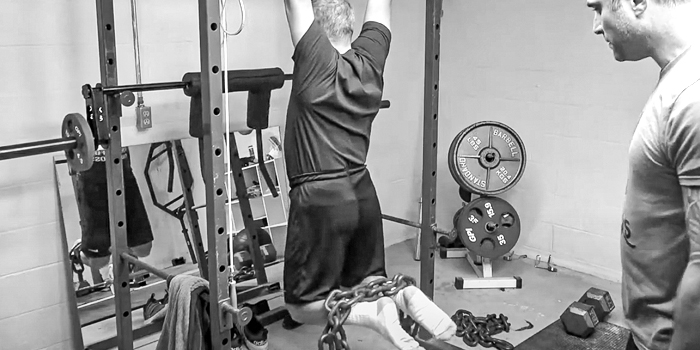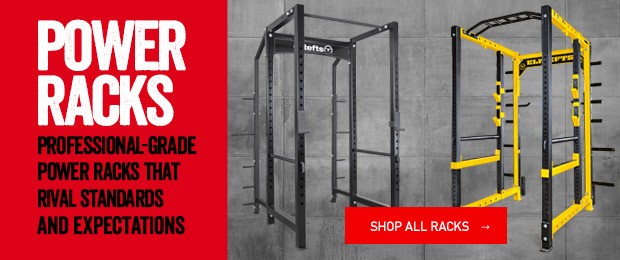
Coauthored by Scott H. Mendelson and Dr. Eric Serrano
Flexing the hamstrings from a hanging position serves as a highly productive exercise and, more importantly, a performance evaluation tool that coaches can easily apply without fancy equipment. The ability to flex the hamstrings by bringing the heels towards the glutes and holding a parallel position for thirty seconds is harder to achieve than what many would think, even for elite professional athletes. Increased range of motion will enable athletes to bring the heels closer to the glutes over time and maintain that flexed position with various loading parameters. Power athletes can improve their competition squat, deadlift, and other movements by sharpening the coordinated strength of the hamstrings, glutes, lats, and grip elements.
A Simple Diagnostic Tool
Dr. Eric Serrano has found the inability to execute the Hanging Hamstring Raise correctly leads to a high risk of low back pain, hamstring cramps during competition, and the inability to maximize performance. The Hanging Hamstring Raise sequence trains the entire superficial back line, focusing on the latissimus dorsi, hamstrings, and glutes firing in coordination just as they do in competition. These hanging variations, especially those with the added load, will improve grip strength tremendously. The lats are often an overlooked part of the posterior chain, and dysfunction of back muscles can negatively impact lower body musculature function. Remember, an athlete is only as strong as the weakest link, especially related to relationships between sprinting and the posterior chain.
Distance Coaching Opportunities
A coach distanced from athletes due to facility closures related to COVID-19 can easily assign these specialized movements to a pair of trainees with a pull-up bar and simple loading implements. Pictures generated by the training partner with a smartphone are very useful for the trainees themselves and coaches evaluating incremental performance. Hanging Hamstring Raises and modifications can be performed in a competitive environment with many athletes at the same time without an equipment bottleneck. A group of two to four training partners can be highly time-efficient with squat rack stations that have a standard pull-up bar.
Training Frequency
A competitive athlete and responsible coaches monitor recovery very closely. Initially, we recommend using the Hanging Hamstring Raise one time per week and at least three days before competition to allow for recovery of the nervous system and reduce muscle soreness. Using this exercise at the start of a lower-body workout serves as an excellent warm-up tool. It creates the ideal training effect for addressing weaknesses before fatigue sets in as the training session progresses. The first few workouts can feature three work sets in superset fashion with a quad-dominant movement such as a lunge. Focus on achieving and maintaining the proper position for thirty seconds per set before adding external loading in subsequent weeks.
MORE: Anchored Band Squats for Unmatched Quad and Glute Power
Dr. Serrano brings the feet to the ideal spot so the trainee can feel and maintain the proper position throughout the exercise. Some athletes are so tight or dysfunctional that they need help to engage the hamstrings initially, which is a humbling process. Notice that Dr. Serrano is demanding plantar flexion by manipulating the position of the toes.
Loading Progressions
Like any other exercise, the loading implementation should be gradual in nature. In addition to weight load, the surface area of medicine balls impacts the difficulty of the exercise. Dr. Serrano may try several different size medicine balls, load amounts, and force curves with bands and chains during a training session to address specific weaknesses observed during his evaluation of the first Hanging Hamstring Raise set. A trained eye can look at the glutes, hamstrings, and calves to identify weaknesses in the posterior chain. The key to success is getting the athlete in the proper position and encouraging them to maintain that exact position against resistance for thirty seconds. Mental toughness is required!
Hanging Hamstring Raises loaded with chains add tremendous challenge to the exercise. As fatigue sets in, most athletes will experience the feet moving downwards towards the floor, which will cause the chains to slip off. Starting with a fifteen-second hold and progressing to thirty seconds with a twenty-pound chain is a great achievement. Notice Dr. Serrano prefers a grip without wrapping the thumb around the bar. Not using the thumb wrap can reduce the risk of developing elbow pain during extended hanging positions in the range of thirty seconds.
Fighting against the band resistance to keep the body in the middle of the squat rack adds functional core challenge.
Anchoring a low tension band to the side of the squat rack provides a unique set of stimuli for trainees immediately. The athlete must focus keeping the body centered within the squat rack despite the band pulling towards the post of the squat rack. This specific band placement increases hamstring activation and challenges the stabilizers.
A small medicine ball is being squeezed between the knees throughout the set which is hard to see. The act of squeezing as hard as you can adds tremendous challenge and ultimately benefit.
Squeezing the medicine ball between the knees during the hanging hamstring movement isolates the adductor effectively. The ball itself can add additional loading, however, the ability to maintain the squeezed position with tension is more important than the loading. A smooth ball with a small surface area is much harder to pinch than a larger ball that may be heavier.
A partner providing an accurate time count is important for the duration of each set. The trainee under load tends to count too fast due to the difficulty of the exercise!
Pushing on the large medicine ball with back of the feet into the glutes is an important contractile task. The medicine ball can add a significant amount of load which is difficult to hold when a band is pulling sideways from the post.
Toe Position Importance
Plantarflexion increases the intensity and value of the contraction. Dr. Serrano emphasizes plantar flexion by using his hands to put the feet and the toes in the proper position for the athlete performing the hanging hamstring raise. Feeling the proper position is important as the athlete cannot see the actual position while facing the other direction. However, athletes can feel certain positions and use that memory to replicate the position at a later date as a key element of the quality of execution. Plantar Fasciitis conditions can be improved by executing proper plantarflexion during the Hanging Hamstring Raise based on Dr. Serrano’s work with individual patients and professional team environments.
Please send questions and requests for future article topics to Scott@infinityfitness.com.
Scott H. Mendelson, director of www.InfinityFitness.com, is a highly regarded performance nutrition and training specialist. In addition to designing customized programs for his celebrity, weekend warrior and executive clients, Scott works daily with professional athletes from the NFL, NHL, MLB, NBA, and NCAA. Scott has built an excellent reputation providing effective supplements, cutting-edge information, and unmatched service to thousands of clients worldwide since 1999.
Scott@infinityfitness.com Special assistant to Dr. Eric Serrano MD, Scott helps with the design of training, nutrition and supplementation trials to confirm the effectiveness of protocols and expand his expertise.
Dr. Eric Serrano, MD, is the ace sought out by elite athletes and business professionals around the world for help with the most difficult of problems. Dr. Serrano spends a majority of his time promoting the success of his family practice patients in Pickerington; a suburb of Columbus Ohio. Amongst the thousands of patients are elite athletes from around the globe who will travel to the ends of the earth to consult with Dr. Serrano.










4 Comments